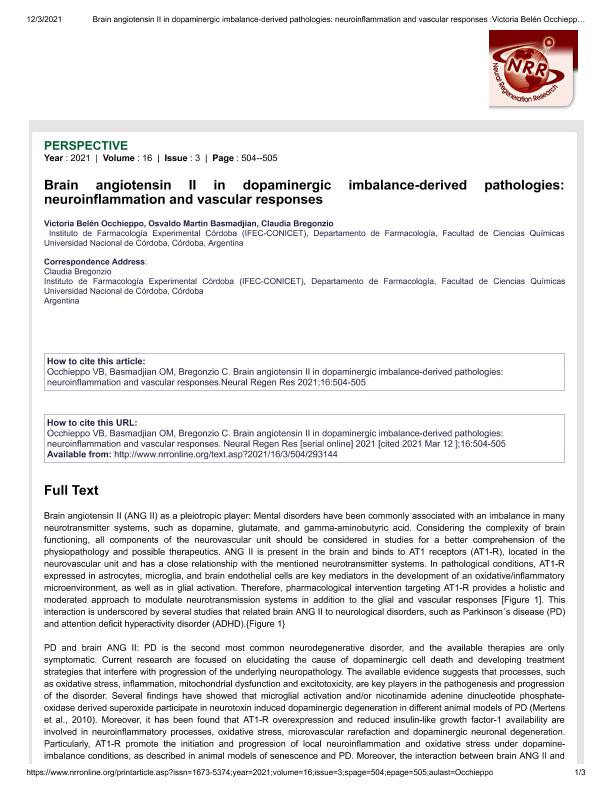Artículo
Brain angiotensin II in dopaminergic imbalance-derived pathologies: Neuroinflammation and vascular responses
Fecha de publicación:
03/2021
Editorial:
Shenyang Editorial Dept Neural Regeneration Res
Revista:
Neural Regeneration Research
ISSN:
1673-5374
e-ISSN:
1876-7958
Idioma:
Inglés
Tipo de recurso:
Artículo publicado
Clasificación temática:
Resumen
Brain angiotensin II (ANG II) as a pleiotropic player: Mental disorders have been commonly associated with an imbalance in many neurotransmitter systems, such as dopamine, glutamate, and gamma-aminobutyric acid. Considering the complexity of brain functioning, all components of the neurovascular unit should be considered in studies for a better comprehension of the physiopathology and possible therapeutics. ANG II is present in the brain and binds to AT1 receptors (AT1-R), located in the neurovascular unit and has a close relationship with the mentioned neurotransmitter systems. In pathological conditions, AT1-R expressed in astrocytes, microglia, and brain endothelial cells are key mediators in the development of an oxidative/inflammatory microenvironment, as well as in glial activation. Therefore, pharmacological intervention targeting AT1-R provides a holistic and moderated approach to modulate neurotransmission systems in addition to the glial and vascular responses [Figure 1]. This interaction is underscored by several studies that related brain ANG II to neurological disorders, such as Parkinson´s disease (PD) and attention deficit hyperactivity disorder (ADHD).
Palabras clave:
Angiotensin II
,
Dopamine
,
Schizophrenia
,
Depression
Archivos asociados
Licencia
Identificadores
Colecciones
Articulos(IFEC)
Articulos de INST. DE FARMACOLOGIA EXPERIMENTAL DE CORDOBA
Articulos de INST. DE FARMACOLOGIA EXPERIMENTAL DE CORDOBA
Citación
Occhieppo, Victoria Belen; Basmadjian, Osvaldo Martin; Bregonzio Diaz, Claudia; Brain angiotensin II in dopaminergic imbalance-derived pathologies: Neuroinflammation and vascular responses; Shenyang Editorial Dept Neural Regeneration Res; Neural Regeneration Research; 16; 3; 3-2021; 504-505
Compartir
Altmétricas




